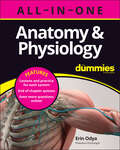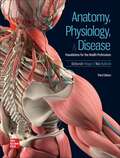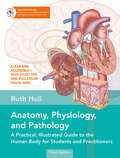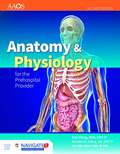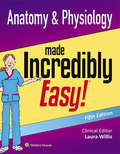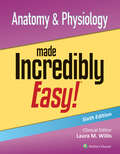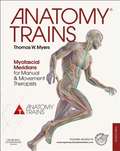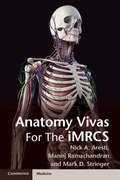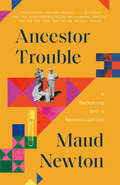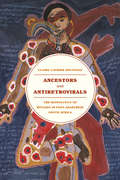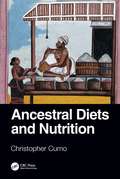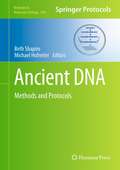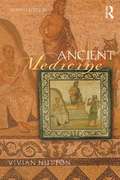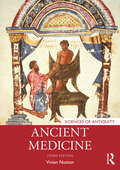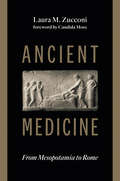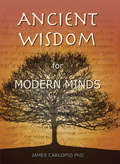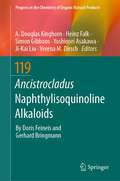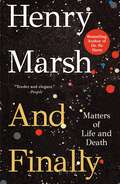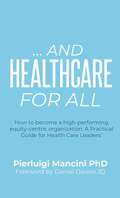- Table View
- List View
Anatomy & Physiology All-in-One For Dummies (+ Chapter Quizzes Online)
by Erin OdyaThe knee-bone’s connected to the…what was it again? From complicated Latin names to what can seem like a million-and-one things to memorize, no one's saying anatomy and physiology is easy. But, with a little help from your friends at Dummies, it doesn't have to be impossible! Anatomy & Physiology All-in-One For Dummies is your go-to guide for developing a deep understanding of the parts of the human body and how it works. You’ll learn the body's structures and discover how they function with expert help from the book's easy-to-use teaching features. You can even go online to access interactive chapter quizzes to help you absorb the material. With this book, you'll: Get a grip on key concepts and scientific terminology used to describe the human body Discover fun physiology facts you can apply to everyday life both inside and outside the classroom Learn how the body's different systems interact with one another So, if you’re looking to ace that next test, improve your overall grade, reduce test anxiety, or just increase your confidence in the subject, grab a copy of Anatomy & Physiology All-in-One For Dummies. It's your one-stop, comprehensive resource for all things A&P!
Anatomy, Physiology, and Disease: Foundations for the Health Professions
by Deborah Roiger Nia BullockRoiger and Bullock’s unique pedagogical and visual approach helps students make the important connections between systems and learn how the body functions normally in homeostasis, and how disruption of homeostasis leads to disease and disorder. With a straightforward, engaging writing style, the authors explain difficult concepts in the context of routine activities, making concepts easier to grasp. Measurable learning outcomes throughout the textbook, workbook, and digital learning and assessment program help direct students through the content so there are no surprises. Anatomy, Physiology, Disease requires no prior knowledge of chemistry or cell biology, and is designed for an anatomy and physiology course or an anatomy, physiology, and pathology course. It is neither too high nor too low and can be customized to accommodate the organization of individual courses.
Anatomy, Physiology And Disease: Foundations For The Health Professions
by Deborah Roiger Nia Joyner BullockIn Roiger/Bullock, connections are made between systems so that students learn how the body functions normally in homeostasis, and how disruption of homeostasis leads to disease and disorder. With a straightforward writing style that engages the reader directly, the authors explain difficult concepts in the context of daily activities, making them easier to grasp. A one-column design and brand new art program also makes the content more inviting and facilitates comprehension in students. Chapters are mapped out by specific learning outcomes so that there are no surprises, and all exercises throughout the text, workbook, and digital ancillaries are directly tied to these measurable outcomes. Integrated digital content includes Body ANIMAT3D and audio pronunciations. Roiger and Bullock’s text requires no prior knowledge of chemistry or cell biology, and is designed for a one-semester, entry-level A&P course.
Anatomy, Physiology, and Pathology, Third Edition: A Practical, Illustrated Guide to the Human Body for Students and Practitioners--Clear and accessible, with study tips and full-color visual aids
by Ruth HullA full-color, easy-to-understand introduction to anatomy, physiology, and pathology that's designed to provide a comprehensive understanding of the human body without overwhelming readers.Anatomy, Physiology, and Pathology is the ideal introduction on the topic for students of complementary and physical therapies. Designed for ease of learning both as an independent study resource and in the classroom, this textbook is suitable for anyone requiring detailed knowledge of these subjects and has been adopted by colleges worldwide.Author and therapist Ruth Hull provides a thorough understanding of anatomy, physiology, and pathology with clear, accessible language and helpful learning tools. It&’s designed for easy comprehension, with more than 300 clearly labeled color images; flow charts, diagrams, and tables to help visualize complex ideas; study tips; practice questions in each chapter; and more.Chapters outline the following systems:Skin, hair, and nailsSkeletal, muscular, and nervous systemsEndocrine and respiratory systemsCardiovascular, lymphatic, and immune systemsDigestive systemUrinary systemReproductive systemThis book also serves as an effective refresher for current healthcare and bodywork professionals.
Anatomy & Physiology for the Prehospital Provider
by American Academy of Orthopaedic SurgeonsTo properly assess and manage a patient, a prehospital provider must have a solid foundation in human anatomy and physiology. Anatomy & Physiology for the Prehospital Provider, Second Edition, uses a systemic approach to building this foundation. It begins by providing an overview of the basic systems of the human body and then explores each system in detail chapter by chapter, delivering a thorough discussion on the system's anatomy, physiology, and pathophysiology. With clear, accessible language and informative illustrations, the Anatomy & Physiology for the Prehospital Provider, Second Edition is an effective and engaging learning experience. <P><P>Strong Application to Real-World EMS <P><P>Progressive patient case studies evolve throughout every chapter, offering the learner genuine context for the application of the knowledge presented. This approach shows the learner how all of the information will be used to help patients in the field. <P><P>The Second Edition content includes: <P><P>New section on the basics of chemistry Expanded section on joints Expanded content on muscular physiology Updated illustrations Additional pathophysiology, including cellular injury
Anatomy & Physiology Made Incredibly Easy! (Incredibly Easy! Series® #2)
by Lippincott Williams WilkinsNo need to feel stressed over anatomy and physiology—grasp all the basic terms and concepts, with the fully updated Anatomy and Physiology Made Incredibly Easy!, 5th Edition. Using humor and friendly guidance, this colorful text gives you the pure-and-simple clarity you need to understand the basic structure and functions of all major body systems, while also guiding you through genetics, nutrition, reproduction, and more. This handy quick-reference guide is the ideal NCLEX® study aid, textbook support, or quick refresher for nurses and other healthcare practitioners. Grasp the details of anatomy and physiology, in the Incredibly Easy!® way . . . NEW and completely updated content in easy-read format to simplify the core concepts of anatomy and physiology Defines anatomic terms such as cell structure, cell reproduction and energy generation, the four basic tissue types and their characteristics, and more End-of-book, pocket-sizedstudy cards for easy review anywhere, anytime Explains the forms and locations of body structures – the directional terms, reference planes, cavities, and regions of every major body system Dozens of full-color drawings and diagrams illustrating all major body systems—integumentary, musculoskeletal, neurosensory, endocrine, cardiovascular, and more, plus: fluids and electrolytes reproduction and lactation genetics nutrition chemical organization Special features include: “Nurse Joy” and “Jake” – expert insights, key concepts, and important care reminders Zoom in – an up-close look at anatomic structures Now I get it! – complex physiology processes stated in easy-to-handle terms Just the facts – quick content summary at start of each chapter Quick quiz – multiple-choice questions at end of each chapter to help you retain what you learned Senior moment – explains physiologic changes that occur with aging in each body system Body shop – illustrates how body systems and structures work together Memory jogger – helpful tricks and tips to help you retain vital data Just for fun – fun puzzles for boosting your understanding of anatomical terms and pathophysiological concepts Practice Makes Perfect – end-of-book NCLEX® practice questions, for solid exam preparation
Anatomy & Physiology Made Incredibly Easy!
by Laura WillisDon’t stress over anatomy and physiology—mastering basic terms and concepts is a breeze with Anatomy and Physiology Made Incredibly Easy, 6th Edition. This clever, colorful, clearly written guide makes fundamental anatomy and physiology structures and functions approachable while delivering fun, friendly guidance to help you ensure success throughout your nursing career
Anatomy Trains: Myofascial Meridians For Manual And Movement Therapists
by Thomas MyersThe new edition of this hugely successful book continues to present a unique understanding of the role of fascia in healthy movement and postural distortion which is of vital importance to bodyworkers and movement therapists worldwide. Fully updated throughout and now with accompanying website (www.myersmyofascialmeridians.com), Anatomy Trains: Myofascial Meridians for Manual and Movement Therapists will be ideal for all those professionals who have an interest in human movement: massage therapists, structural integration practitioners, craniosacral therapists, yoga teachers, osteopaths, manual therapists, physiotherapists, athletic trainers, personal trainers, dance and movement teachers, chiropractors and acupuncturists.
Anatomy Vivas for the Intercollegiate MRCS
by Manoj Ramachandran Nick Aresti Mark StringerPresented in a question-and-answer format, Anatomy Vivas for the Intercollegiate MRCS will help candidates prepare for the anatomy section of the new Intercollegiate MRCS exam and will aid their learning in the format in which they will be tested. The book is unique in that it is based on the new examination. It is divided into the specialty areas and is based on clinical scenarios. Featuring photographs of dissections, detailed diagrams and radiographic images, the book is the most concise and accurate anatomy aid for the MRCS examination. Written by recent candidates, experienced surgical anatomists and authors of other successful MRCS guides, it features explanations presented in a memorable, logical and easy to learn manner, and highlights areas that regularly feature in the exam. Past questions, core topics and recurring themes are discussed in detail, ensuring that candidates are as prepared as possible. It is an indispensable guide to success.
Ancestor Trouble: A Reckoning and a Reconciliation
by Maud NewtonONE OF THE MOST ANTICIPATED BOOKS OF 2022—Oprah Daily, Time, Esquire, The Millions, The Week, Thrillist, She Reads, Lit Hub, BookPage. <p><p> Maud Newton’s ancestors have vexed and fascinated her since she was a girl. Her mother’s father, who came of age in Texas during the Great Depression, was said to have married thirteen times and been shot by one of his wives. Her mother’s grandfather killed a man with a hay hook and died in an institution. <p><p> Mental illness and religious fanaticism percolated through Maud’s maternal lines back to an ancestor accused of being a witch in Puritan-era Massachusetts. Maud’s father, an aerospace engineer turned lawyer, was an educated man who extolled the virtues of slavery and obsessed over the “purity” of his family bloodline, which he traced back to the Revolutionary War. He tried in vain to control Maud’s mother, a whirlwind of charisma and passion given to feverish projects: thirty rescue cats, and a church in the family’s living room where she performed exorcisms. <p><p> Her parents’ divorce, when it came, was a relief. Still, her position at the intersection of her family bloodlines inspired in Newton inspired an anxiety that she could not shake, a fear that she would replicate their damage. She saw similar anxieties in the lives of friends, in the works of writers and artists she admired. As obsessive in her own way as her parents, Newton researched her genealogy—her grandfather’s marriages, the accused witch, her ancestors’ roles in slavery and genocide—and sought family secrets through her DNA. But immersed in census archives and cousin matches, she yearned for deeper truths. Her journey took her into the realms of genetics, epigenetics, and the debates over intergenerational trauma. She mulled over modernity’s dismissal of ancestors along with psychoanalytic and spiritual traditions that center them.
Ancestors and Antiretrovirals: The Biopolitics of HIV/AIDS in Post-Apartheid South Africa
by Claire Laurier DecoteauIn the years since the end of apartheid, South Africans have enjoyed a progressive constitution, considerable access to social services for the poor and sick, and a booming economy that has made their nation into one of the wealthiest on the continent. At the same time, South Africa experiences extremely unequal income distribution, and its citizens suffer the highest prevalence of HIV in the world. As Archbishop Desmond Tutu has noted, AIDS is South Africa s new apartheid. In "Ancestors and Antiretrovirals," Claire Laurier Decoteau backs up Tutu s assertion with powerful arguments about how this came to pass. Decoteau traces the historical shifts in health policy after apartheid and describes their effects, detailing, in particular, the changing relationship between biomedical and indigenous health care, both at the national and the local level. Decoteau tells this story from the perspective of those living with and dying from AIDS in Johannesburg s squatter camps. At the same time, she exposes the complex and often contradictory ways that the South African government has failed to balance the demands of neoliberal capital with the considerable health needs of its population. "
Ancestors and Antiretrovirals: The Biopolitics of HIV/AIDS in Post-Apartheid South Africa
by Claire Laurier DecoteauIn the years since the end of apartheid, South Africans have enjoyed a progressive constitution, considerable access to social services for the poor and sick, and a booming economy that has made their nation into one of the wealthiest on the continent. At the same time, South Africa experiences extremely unequal income distribution, and its citizens suffer the highest prevalence of HIV in the world. As Archbishop Desmond Tutu has noted, “AIDS is South Africa’s new apartheid.” In Ancestors and Antiretrovirals, Claire Laurier Decoteau backs up Tutu’s assertion with powerful arguments about how this came to pass. Decoteau traces the historical shifts in health policy after apartheid and describes their effects, detailing, in particular, the changing relationship between biomedical and indigenous health care, both at the national and the local level. Decoteau tells this story from the perspective of those living with and dying from AIDS in Johannesburg’s squatter camps. At the same time, she exposes the complex and often contradictory ways that the South African government has failed to balance the demands of neoliberal capital with the considerable health needs of its population.
Ancestral Diets and Nutrition
by Christopher CumoAncestral Diets and Nutrition supplies dietary advice based on the study of prehuman and human populations worldwide over the last two million years. This thorough, accessible book uses prehistory and history as a laboratory for testing the health effects of various foods. It examines all food groups by drawing evidence from skeletons and their teeth, middens, and coprolites along with written records where they exist to determine peoples&’ health and diet. Fully illustrated and grounded in extensive research, this book enhances knowledge about diet, nutrition, and health. It appeals to practitioners in medicine, nutrition, anthropology, biology, chemistry, economics, and history, and those seeking a clear explanation of what humans have eaten across the ages and what we should eat now. Features: Sixteen chapters examine fat, sweeteners, grains, roots and tubers, fruits, vegetables, and animal and plant sources of protein. Integrates information about diet, nutrition, and health from ancient, medieval, modern and current sources, drawing from the natural sciences, social sciences, and humanities. Provides comprehensive coverage based on the study of several hundred sources and the provision of over 2,000 footnotes. Presents practical information to help shape readers&’ next meal through recommendations of what to eat and what to avoid.
Ancestral Genomics: African American Health in the Age of Precision Medicine
by Constance B. HilliardA leading evolutionary historian offers a radical solution to racial health disparities in the United States.Constance B. Hilliard was living in Japan when she began experiencing joint pain. Her doctor diagnosed osteoarthritis—a common ailment for someone her age. But her bloodwork showed something else: Hilliard, who had never had kidney problems, appeared to be suffering from renal failure. When she returned to Texas, however, a new round of tests showed that her kidneys were healthy. Unlike the Japanese doctor, her American primary care provider had checked a box on her lab report for “African American.” As a scholar of scientific racism, Hilliard was perplexed. Why should race, which experts agree has no biological basis, matter for getting accurate test results?Ancestral Genomics is the result of Hilliard’s decade-long quest to solve this puzzle. In a masterful synthesis of evolutionary history, population genetics, and public health research, she addresses the usefulness of race as a heuristic in genomic medicine. Built from European genetic data, the Human Genome Project and other databases have proven inadequate for identifying disease-causing gene variants in patients of African descent. Such databases, Hilliard argues, overlook crucial information about the environments to which their ancestors’ bodies adapted prior to the transatlantic slave trade. Hilliard shows how, by analyzing “ecological niche populations,” a classification model that combines family and ecological histories with genetic information, our increasingly advanced genomic technologies, including personalized medicine, can serve African Americans and other people of color, while avoiding racial essentialism.Forcefully argued and morally urgent, Ancestral Genomics is a clarion call for the US medical community to embrace our multigenomic society.
Ancient DNA: Methods and Protocols (Methods in Molecular Biology #840)
by Michael Hofreiter Beth ShapiroResearch into ancient DNA began more than 25 years ago with the publication of short mitochondrial DNA sequence fragments from the quagga, an extinct relative of the zebra. Ancient DNA research really gained momentum following the invention of PCR, which allowed millions of copies to be made of the few remaining DNA molecules preserved in fossils and museum specimens. In Ancient DNA: Methods and Protocols expert researchers in the field describe many of the protocols that are now commonly used to study ancient DNA. These include instructions for setting up an ancient DNA laboratory, extraction protocols for a wide range of different substrates, details of laboratory techniques including PCR and NGS library preparation, and suggestions for appropriate analytical approaches to make sense of the sequences obtained. Written in the highly successful Methods in Molecular BiologyTM series format, chapters include introductions to their respective topics, lists of the necessary materials and reagents, step-by-step, readily reproducible laboratory protocols, and key tips on troubleshooting and avoiding known pitfalls. Authoritative and practical, Ancient DNA: Methods and Protocols seeks to aid scientists in the further study of ancient DNA and the methodological approaches in ancient research.
Ancient Medicine (Sciences of Antiquity)
by Vivian NuttonThe first edition of Ancient Medicine was the most complete examination of the medicine of the ancient world for a hundred years. The new edition includes the key discoveries made since the first edition, especially from important texts discovered in recent finds of papyri and manuscripts, making it the most comprehensive and up-to-date survey available. Vivian Nutton pays particular attention to the life and work of doctors in communities, links between medicine and magic, and examines the different approaches to medicine across the ancient world. The new edition includes more on Rufus and Galen as well as augmented information on Babylonia, Hellenistic medicine and Late Antiquity. With recently discovered texts made accessible for the first time, and providing new evidence, this broad exploration challenges currently held perspectives, and proves an invaluable resource for students of both classics and the history of medicine.
Ancient Medicine (Sciences of Antiquity)
by Vivian NuttonThe third edition of this magisterial account of medicine in the Greek and Roman worlds, written by the foremost expert on the subject, has been updated to incorporate the many new discoveries made in the field over the past decade. This revised volume includes discussions of several new or forgotten works by Galen and his contemporaries, as well as of new archaeological material. RNA analysis has expanded our understanding of disease in the ancient world; the book explores the consequences of this for sufferers, for example in creating disability. Nutton also expands upon the treatment of pre-Galenic medicine in Greece and Rome. In addition, subtitles and a chronology will make for easier student consultation, and the bibliography is substantially revised and updated, providing avenues for future student research. This third edition of Ancient Medicine will remain the definitive textbook on the subject for students of medicine in the classical world, and the history of medicine and science more broadly, with much to interest scholars in the field as well.
Ancient Medicine: From Mesopotamia to Rome
by Laura M. ZucconiThis book by Laura Zucconi is an accessible introductory text to the practice and theory of medicine in the ancient world. In contrast to other works that focus heavily on Greece and Rome, Zucconi&’s Ancient Medicine covers a broader geographical and chronological range. The world of medicine in antiquity consisted of a lot more than Hippocrates and Galen.Zucconi applies historical and anthropological methods to examine the medical cultures of not only Mesopotamia, Egypt, Greece, and Rome but also the Levant, the Anatolian Peninsula, and the Iranian Plateau. Devoting special attention to the fundamental relationship between medicine and theology, Zucconi&’s one-volume introduction brings the physicians, patients, procedures, medicines, and ideas of the past to light.
Ancient Medicine: From Mesopotamia to Rome
by Laura M. ZucconiThis book by Laura Zucconi is an accessible introductory text to the practice and theory of medicine in the ancient world. In contrast to other works that focus heavily on Greece and Rome, Zucconi&’s Ancient Medicine covers a broader geographical and chronological range. The world of medicine in antiquity consisted of a lot more than Hippocrates and Galen.Zucconi applies historical and anthropological methods to examine the medical cultures of not only Mesopotamia, Egypt, Greece, and Rome but also the Levant, the Anatolian Peninsula, and the Iranian Plateau. Devoting special attention to the fundamental relationship between medicine and theology, Zucconi&’s one-volume introduction brings the physicians, patients, procedures, medicines, and ideas of the past to light.
Ancient Remedies: Secrets to Healing with Herbs, Essential Oils, CBD, and the Most Powerful Natural Medicine in History
by Dr. Josh AxeBestselling author Dr. Josh Axe explains how to treat more than seventy diseases, lose weight, and increase vitality with traditional healing practices passed down through the ages.Long before the first pharmaceutical companies opened their doors in the 1850s, doctors treated people, not symptoms. And although we've become used to popping pills, Americans have finally had it with the dangerous side effects, addiction and over-prescribing—and they're desperate for an alternative.Here's the good news: That alternative has been here all along in the form of ancient treatments used for eons in traditional Chinese, Ayurvedic and Greek medicine. Ancient Remedies is the first comprehensive layman's guide that will bring together and explain to the masses the very best of these time-tested practices.In Ancient Remedies, Dr. Axe explores the foundational concepts of ancient healing—eating right for your type and living in sync with your circadian clock. Readers will learn how traditional practitioners identified the root cause of each patient's illness, then treated it with medicinal herbs, mushrooms, CBD, essential oils, and restorative mind-body practices. What's more, they'll discover how they can use these ancient treatments themselves to cope with dozens of diseases, from ADHD to diabetes, hypothyroidism, autoimmune disease, and beyond.Through engaging language and accessible explanations, Ancient Remedies teaches readers everything they need to know about getting, and staying, healthy—without toxic, costly synthetic drugs.
Ancient Wisdom for Modern Minds: A Thinking Heart and a Feeling Mind
by James CarlopioThoughts, reflections and experiences voiced by ancient sages appear in this book as 'coaching conversations'. Their wisdom creates a vibrant landscape populated with insights which help us to reflect upon and discuss emotions encountered in personal transformation and constant workplace change. They allow us to process past experiences and emotions in order to move on. James Carlopio shows us that coaching for personal improvement has occurred since time-immemorial. These ancient quotes illuminate modern-day socio-cognitive constructs and techniques used in coaching psychology. The 'coaching conversation' itself is grounded in the constructivist-narrative approaches used within Solution-Focused Brief Therapy. These ancient quotes will assist readers to undergo personal transitions, Executive Coaches to facilitate workplace change and Life Coaches in personal development. Positive Psychology and important areas in coaching psychology are referenced in the Introduction and section openings. Supported by a subject index, this luminous work is grouped into sections addressing: awareness of self and others life, death, health and happiness wisdom, communication and learning achievement, goals and effort The text is designed to help people access emotion, express emotion, acknowledge emotion, release emotion and move on gracefully to happier, more successful and less stressed lives.
Ancistrocladus Naphthylisoquinoline Alkaloids (Progress in the Chemistry of Organic Natural Products #119)
by A. Douglas Kinghorn Heinz Falk Simon Gibbons Yoshinori Asakawa Ji-Kai Liu Verena M. DirschThis book describes a unique class of secondary metabolites, the mono- and dimeric-naphthylisoquinoline alkaloids. They exclusively occur in lianas of the palaeotropical Ancistrocladaceae and Dioncophyllaceae plant families. Their unprecedented structures include stereogenic centers and rotationally hindered, and therefore stereogenic, axes. Extended recent investigations on six Ancistrocladus species from Asia, as reported in this contribution, shed light on their fascinating phytochemical productivity, with over 100 intriguing natural products. This high chemodiversity arises from a similarly unique biosynthesis from acetate-malonate units, following a novel polyketidic pathway to plant-derived isoquinoline alkaloids. Some of the compounds show most promising anti-parasitic activities. Additionally, strategies for the regio- and stereoselective total synthesis of the alkaloids, including the directed construction of the chiral axis, are also presented.
And Finally: Matters of Life and Death
by Henry MarshFrom the bestselling neurosurgeon and author of Do No Harm, comes Henry Marsh's And Finally, an unflinching and deeply personal exploration of death, life and neuroscience.As a retired brain surgeon, Henry Marsh thought he understood illness, but he was unprepared for the impact of his diagnosis of advanced cancer. And Finally explores what happens when someone who has spent a lifetime on the frontline of life and death finds himself contemplating what might be his own death sentence.As he navigates the bewildering transition from doctor to patient, he is haunted by past failures and projects yet to be completed, and frustrated by the inconveniences of illness and old age. But he is also more entranced than ever by the mysteries of science and the brain, the beauty of the natural world and his love for his family. Elegiac, candid, luminous and poignant, And Finally is ultimately not so much a book about death, but a book about life and what matters in the end.
...And Healthcare for All: ‘How to become a high-performing, equity-centric organization: A Practical Guide for Health Care Leaders’
by Pierluigi ManciniThis book is for leaders who are seeking to make a tangible impact on reducing inequities in physical and mental health and are willing to take deliberate steps towards achieving it. It is a reminder of what is at stake if opportunities for achieving health equity are missed. The author shares inspiring and cautionary stories, along with clearly articulated tips that can guide organizations towards becoming more culturally and linguistically responsive. This book is ideal for individuals and organizations who are committed to addressing health equity issues but struggle to see a clear path forward. The book provides a concise resource and tool that organizations can use to begin or continue their journey towards health equity.
And How Are You, Dr. Sacks?: A Biographical Memoir of Oliver Sacks
by Lawrence Weschler“A wonderful portrayal of a brilliant, eccentric man,” this biographical memoir by an award-winning author is the untold story of Dr. Oliver Sacks (People).Lawrence Weschler began spending time with Oliver Sacks in the early 1980s, when he was profiling the neurologist for The New Yorker. Almost a decade earlier, Dr. Sacks had published Awakenings—the account of his long-dormant patients’ miraculous return to life. Over the ensuing four years, the two men worked closely together until, for personal reasons, Sacks asked Weschler to abandon the profile. The two remained close friends over the next thirty years and then, just as Sacks was dying, he urged Weschler to take up the project once again. This book is the result of that entreaty.Weschler sets Sacks’s brilliant personality in vivid relief. We see Sacks rowing and ranting and caring deeply; composing the essays that would form The Man Who Mistook His Wife for a Hat and waging intellectual war against a medical and scientific establishment that failed to address his greatest concern: the spontaneous specificity of the individual human soul. Here is the definitive portrait of Sacks, whose entire practice revolved around the single fundamental question he asked each of his patients: How are you? Which is to say, How do you be?A question which Weschler, with this book, turns back on the good doctor himself.“Engrossing. . . . This is Sacks at full blast: on endless ward rounds, observing his post-encephalitic patients . . . exulting over horseshoe crabs and chunks of Iceland spar.” —Barbara Kiser, Nature“Thoroughly engaging and enchanting.” —Kirkus Reviews, starred review“Does a particularly good job intertwining Sacks’s searching empathy with his sheer strangeness.” —New York Times Book Review
